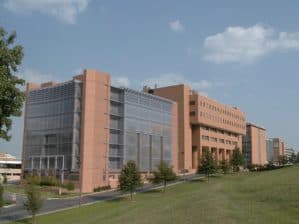Patrick W. Tank Anatomy Teaching Complex in the Rahn IPE Building

The anatomy teaching complex is named in memory of the late Dr. Patrick W. Tank, a gifted educator and anatomist, who taught at UAMS for 34 years and directed the medical gross anatomy course. The 19,000-square-foot anatomy teaching complex occupies the entire basement level of the Rahn Building. This part of the building was completed in 1995 and further expanded in 2009.
To better educate a sophisticated health care workforce for the 21st century, a 1.3 million dollar investment in 2018 renovated the laboratory and added state of the art technology.
The Teaching Complex is a cluster of modern laboratories and specialized study spaces for small group and individual learning. The Division of Clinical Anatomy oversees all educational activities housed within the Teaching Complex.
Its large dissection lab (about 8,000 square feet) is equipped with 14 computer monitors, seven large glass white boards, multiple deep sinks, and emergency eye washing stations. It has a study alcove that accommodates about 25 students, which is equipped with both a 75-inch SMART Board and a separate 60-inch monitor equipped for HDMI input. This is especially helpful when demonstrating ultrasound techniques. In addition, the Teaching Complex includes the following:
- A separate cross-sectional anatomy room (325 square feet) that houses two complete cross-sectional anatomy specimens and a new (April, 2018) 4K SECTRA Table from Touch of Life Technologies. This is a large computer-driven virtual dissection table for student learning through interaction with representations of real bodies. At the vanguard of anatomy education is the use of large computerized virtual dissection/autopsy tables that can display representations of real bodies with the capacity to cut away “tissue” and rotate the body. Moreover, the device can display actual cross-sectional images acquired from the U.S. National Library of Medicine or computed tomography (CT) or magnetic resonance imaging (MRI), or images from histological microscopy. This is an exciting technology that has moved beyond exploratory use to practical implementation as a teaching and learning tool.
- A separate study area houses a large collection of plastic models and skeletal material for individual or small group study. It is equipped with a second and newer 75-inch SMART Board (4K ultra-high-definition). The room has five tables where students can comfortably study in groups or collectively work at the SMART Board. This space also serves as a site where students can practice their use of handheld ultrasound devices (GE vScan) and compare ideas on a large glass white board.
- The Teaching Complex also has a separate computer and microscopy room equipped with 16 Dell computers and space for 10 compound light microscopes, where students can examine biopsy specimens and conduct literature searches.
- A separate Clinical Procedure Teaching and Learning Laboratory is located adjacent to the main dissection lab. This room utilizes a lightly embalmed cadaver preparation which allows students to gain clinical confidence and competence in a variety of procedures including: ultrasound guided central venous line insertion, ultrasound guided nerve blocks, ultrasound guided biopsy of organs, joint injection and aspiration, bone marrow biopsy and aspiration, chest tube placement, intubation, pericardiocentesis, pleurocentesis, intraosseous line placement, and laparoscopic . The laboratory is equipped with two full laparoscopic towers, two NextGen LOGIQe GE ultrasound laptop devices with four probes, arthroscopes, and two video laryngoscopes. The room is equipped with overhead surgical light and a video camera system for projection to other monitors in the dissection laboratory.
- The Teaching Complex has multiple essential support facilities, these include two restrooms, a total of six faculty and student locker rooms equipped with 290 full size lockers, a dedicated embalming and morgue storage facility, and an office for the administrative staff.
- Finally, the Northwest Arkansas campus is equipped with a comprehensive collection of plastinated prosected cadavers and a virtual reality learning system.

